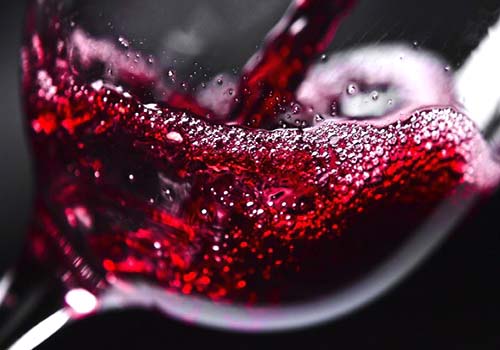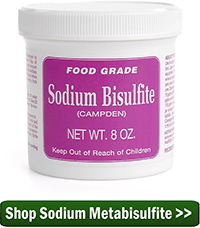 I’ve been making homemade wine for over 30 years. Good friend of mine got me started and he introduced me to E. C. Kraus. I purchased a starter kit from you guys in 1992. Best move that I ever made. That brings me to my story. I make cranberry wine every year and it usually comes out great. Last years batch went cloudy on me. The taste is great, it’s just cloudy (what’s left of it). I’m a little confused as to why. This is the first time this happened. It cleared up nicely. The S.G. was close to .990 and it was very clear. I always use potassium sorbate before bottling. I never had any bubbling when I pulled a cork.
I’ve been making homemade wine for over 30 years. Good friend of mine got me started and he introduced me to E. C. Kraus. I purchased a starter kit from you guys in 1992. Best move that I ever made. That brings me to my story. I make cranberry wine every year and it usually comes out great. Last years batch went cloudy on me. The taste is great, it’s just cloudy (what’s left of it). I’m a little confused as to why. This is the first time this happened. It cleared up nicely. The S.G. was close to .990 and it was very clear. I always use potassium sorbate before bottling. I never had any bubbling when I pulled a cork.
Any advise would be appreciated. I will be bottling about 20 gallons of cranberry before June of this year.
Name: Dan
State: NJ
—–
Hello Dan,
Thanks for the kind words. They are greatly appreciated.
As for your cloudy wine issue, normally I would go through all the basic reasons for a cloudy wine: still fermenting when bottled; picked up sediment from the fermenter when bottling; did not use pectic enzymes in the wine, etc., but it sounds like you’re beyond all that.
So, short of someone playing tricks on you by adding something to your wine, there are only two more reasons I can think of for your wine being cloudy:
Protein Stability:
This is a situation where there is more protein in the wine than the wine can hold. Usually, the protein is in the form of tannin. The tannin is dissolved into the wine, but if the tannin is in excess, it can start to drop out of the wine as little dust particles. This can happen slowly over time, or more rapidly if the wine has been warmed up a few degrees. It will be visible as a fine powder or dust in the wine that slowly starts to form a deposit at the bottom of the wine bottle.
of the wine bottle.
Excess protein/tannin in a wine is caused by over processing the fruit — in this case cranberries — or by leaving the fruit in the fermentation too long. Technically, cranberries only need to be cut in half for a fermentation. I understand that no one is going to sit at the kitchen table all evening cutting cranberries in half, but you want to process the cranberries in a way that does just about that. You could lightly crush them enough to burst the skin. What you don’t want to do is things like chopping them up in a blender or food processor. This is way overkill and releases way too much protein from the fruit. As for the fermentation, I would not leave cranberries in any longer than 5 days.
If this is what has happen you will want to put the wine back into a fermenter. Slightly warm the wine up for a couple of days, say to 80°F. This will encourage the particles to form. Then treat the wine with bentonite. This is a fining agent that will collect and drop out the particles. Rack the wine off the sediment, stir in a dose of sodium metabisulfite and bottle.
Ferric Casse:
This occurs very rarely, but I will bring it up here for the sake of completeness. This can occur if the water used to make the wine has a high iron content. If the water you used does not a have high iron content, don’t even bother reading the rest of this.
The iron in the water, if exposed to enough air, will interact with the protein in the wine causing either white phosphate particles or blue protein particles to form in the wine. Wines that are low in acid, or are stored at cool temperatures are more prone to ferric casse, but this can only happen when the iron content is high.
In this situation you should decant the wine. Put it back into a fermenter. The wine must again be treated with bentonite. Once the wine is completely clear, rack off the sediment and stir in ascorbic acid at the rate of 1/4 teaspoon per gallon. The ascorbic acid will help to lower the pH so that this is not likely to occur again. Then add a dose of sodium metabisulfite and re-bottle.
If I had to guess, you need to look into #1 above. This is by far the most common reason of the two. If you would like to read more about it, we have an article on our website that covers it in a little more detail.
Happy Winemaking,
Ed Kraus
—–
Ed Kraus is a 3rd generation home brewer/winemaker and has been an owner of E. C. Kraus since 1999. He has been helping individuals make better wine and beer for over 25 years.

WOW. I am so glad that question came up. I have the same problem with my wine after a couple years. I have made wine for 7 years and experiment with numerous kinds of fruit. I diffinately leave my must in too long. Thanks
Hello,
Good info. I have just started to make wine(August 2015) I currently have 2 batches of Cranberry going. Dan in NJ what recipes are you using his you don’t mind me asking?
Thanks Ron